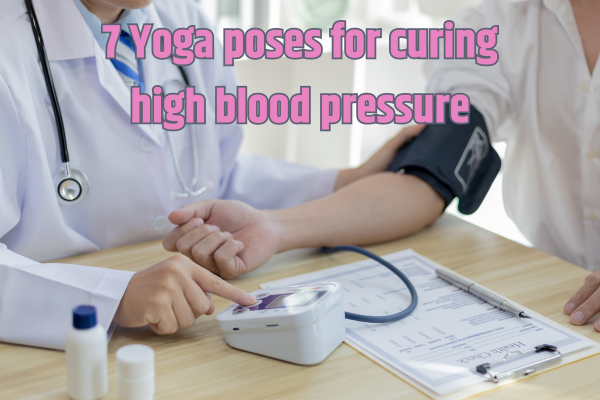Today we are going to know about some yoga poses for curing high blood pressure. High blood pressure aka hypertension, is a medical condition in which the blood pressure in the walls of arteries is persistently too high. High blood pressure is dangerous for health and can become the reasons for death.
Severe Headache, Shortness of Breath, Nausea and Vomiting, Dizziness, Lightheadedness are few symptoms of High BP.
So it’s really important that if you feel these symptoms, you immediately need to see a doctor and get some treatment on it. Because it can cause long term damage to the cardiovascular system and other organs without causing immediate symptoms. And in future, it can become a reason for heart problems, kidney problems too.
If you suspect you have high blood pressure or have concerns about your cardiovascular health, it's important to consult with a healthcare professional. They can provide guidance on monitoring and managing blood pressure, as well as recommend lifestyle changes or medications if necessary.
Few reasons for high blood pressure are age, unhealthy lifestyle, Obesity, consuming tobacco, alcohol, stress. So to avoid this, you need to get a Healthy diet, Reduce weight, Consume less white salt, avoid tobacco and alcohol and do exercise regularly.
Yoga poses for curing high blood pressure
Now we are going to see some yoga poses (yoga asanas) that are beneficial for controlling high blood pressure. But, it should not be considered a substitute for medical treatment. So if you have high blood pressure, you need to take advice from a doctor to do these yoga poses too.
Below are a some commonly recommended yoga poses for curing high blood pressure:
1. Sukhasana (Easy Sitting Pose)
It is a very simple pose and can be done by a person who either doesn’t have a back problem or backbone problem. Also if a person does have problems with legs like injury or something else should avoid this.
Steps -
- Sit comfortably with your legs crossed.
- Lengthen your spine, relax your shoulders, and place your hands on your knees.
- Close your eyes and focus on your breath, taking slow and deep breaths.
This will slowly calm your mind which will automatically result in lowering blood pressure.
2. Balasana (Child's Pose)
It is a kneeling asana and is a counter asana for various asanas. It is usually practiced before and after Sirsasana (Headstand pose) because Sirsasana is an inverted or anti-gravitational asana which increases blood pressure
Steps -
- Kneel on the mat with your big toes touching and knees apart.
- Sit back on your heels and stretch your arms forward, bringing your forehead to the mat.
- Breathe deeply and relax in this resting pose.
3. Paschimottanasana (Seated Forward Bend)
It is a seated forward-bending asana. This asana is called Paschimottanasana as it stretches the entire back of the body from the neck to the ankles.
Steps -
- Sit with your legs extended in front of you.
- Hinge at your hips and reach forward, aiming to touch your toes.
- Keep your spine straight and breathe deeply.
4. Bhujangasana (Cobra Pose)
It is a reclining back-bending asana in hatha yoga. Bhujangasana is one of the asanas under Surya Namaskar. It is good for the backbone and heart too.
Steps -
- Lie on your stomach with your hands placed under your shoulders.
- Inhale and lift your chest off the mat, keeping your elbows slightly bent.
- Focus on lengthening your spine and opening your chest.
5. Setu Bandhasana (Bridge Pose)
It is an inverted back-bending asana in hatha yoga.
Steps -
- Lie on your back with your knees bent and feet hip-width apart.
- Press through your feet and lift your hips toward the ceiling.
- Keep your shoulders on the mat and interlace your fingers beneath your back.
6. Viparita Karani (Legs Up the Wall Pose)
It is commonly a fully supported pose using a wall and sometimes a pile of blankets, where it is considered a restful practice.
Steps -
- Sit with one side of your body against a wall.
- Swing your legs up the wall while lying on your back.
- Rest your arms by your sides and breathe deeply.
7. Anulom Vilom Pranayama (Alternate Nostril Breathing)
It is one of several Pranayama or breath exercises used in the practice of Hatha yoga.
Steps -
- Sit comfortably and close your right nostril with your right thumb.
- Inhale through the left nostril, then close the left nostril with your ring finger and release the right nostril.
- Exhale through the right nostril, then reverse the process.
So, above are some yoga poses for curing high blood pressure. But, before doing these asanas or pranayamas, always remember few things-
- Always do these poses gently.
- Avoid straining or over-exertion.
- Before you start practicing any of the above yoga poses for pranayama you should discuss it with a qualified healthcare professional. They can provide guidance on which exercises are safe and suitable for your specific health condition.
So, today we have seen some yoga poses for curing high blood pressure. If you like this article please share it with family and friends. Thank you.

0 Comments